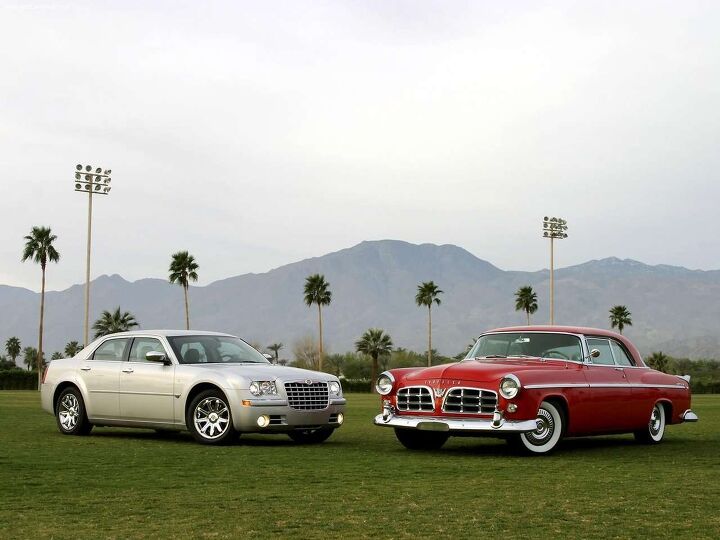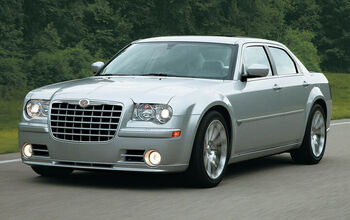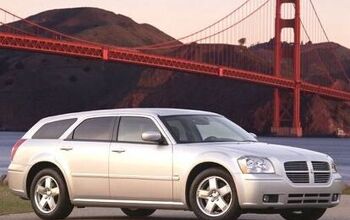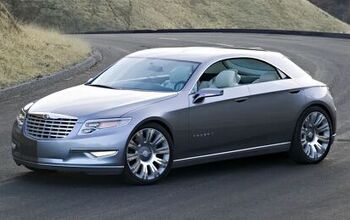Rare Rides Icons: In Memoriam, The Chrysler LX Platform (Part IV)

The Chrysler 300 was the first production car to use the LX platform and was arguably the most important as well. We discussed the debut and styling of the exciting new 300 in our last LX platform installment. When it debuted in 2005 with retro-inspired muscle car styling and a good deal of Mercedes-Benz componentry, it garnered an immediate and positive impression from the buying public with its looks. But did it fare as well on its interior? Let’s find out.
Though Chrysler liked to compare the new 300’s looks to the 300 it offered in the 1950s, it did not pursue a Fifties-inspired interior. Instead, the 300 went more modern American, with chunky shapes and a mix of Chrysler and Mercedes switchgear. The dashboard carried a squared-off architectural look, with a rounded binnacle over the dials, a rectangular one for the center stack, and minimal outside detailing.
The gauges themselves were a bit of a throwback, with black numbers on a white background. Meant to look upmarket, gauges had a sort of British air about them (like a Rover). Set within a dark gray background to match the dash, the dials were flanked by a green LCD screen up top that showed the odometer, and a vertical green LCD screen was used as a shift indicator.
The center stack was trimmed with aluminum effect plastic trim, in a suitably early 2000s brushed finish. A centrally-placed retro-looking analog clock was flanked by vents and sat above the stereo with (optional) CD player, and HVAC controls. The steering wheel featured the same sort of trim as the center stack on each of its four spokes and had a burled wood (faux, or optionally real) insert on the upper quarter of the wheel rim. On some examples said trim was faux tortoise shell.
This same trim was also represented on the door pulls, and on the shift lever. It was a sort of take on what BMW was doing with its wood trim at the time. Elsewhere on the door, a large chrome door handle led to a thick chrome strake that represented the only brightwork on the doors. Side note: observe the sloppy saw work in this cutaway PR photo!
Upper trim 300s had leather interiors in stone, gray, or black. No matter the upholstery color, all 300s had the same two-tone dash treatment inside: A darker gray upper dash with a lighter stone lower half. The color split continued onto the doors and added some visual interest to the otherwise austere cabin.
Automotive press at the time praised the 300’s interior as roomy, efficient, and indeed stylish. While most outlets conveyed the 300 had a well-made quality interior, the TTAC review said otherwise. “The Chrysler 300’s interior continues the cheap and not-so-cheerful theme,” said Sajeev.
Underneath the good (or poor) interior, the rear-drive 300 used many of the same mechanicals as customers found on the front-drive 300M the year prior. Despite its Mercedes-Benz borrowing, the 300’s 2.7-liter EER V6 and 3.5-liter EGG V6 were Chrysler fare from the Nineties. The cheapest 300 customers experienced 190 horsepower from an EER, paired to the four-speed 42RLE automatic from the 300M.
The 3.5-liter V6 made a much more respectable 250 horsepower, shifted through the aforementioned Chrysler four-speed, or the 5-speed W5A580. That code was the other name used by the Mercedes 5G-Tronic automatic. Fortunately, the 300 stepped beyond V6 power and used a couple of V8s as well.
The first of those was a 5.7-liter Hemi, commonly used in RAM trucks since 2003. Good for 340 horsepower and 390 lb-ft of torque, the 5.7 was available only with the five-speed Mercedes automatic. For those seeking max powah the only real option was the SRT-8 trim, which used a 6.1-liter version of the Hemi. It made 425 horsepower and 420 lb-ft of torque which meant the 300 was seriously fast. The SRT reached 60 miles per hour in 4.9 seconds, which was (and is) super quick by sedan standards.
We need to take a quick aside to international markets with regard to engines. There was a diesel version of the 300, only in the Australian and European markets. It was a Mercedes-sourced 3.0-liter V6. A widely used engine from Mercedes, it was also found in the C-, E-, ML-, and S-Class cars. The diesel produced 215 horsepower and 376 lb-ft of torque in the 300 which meant sprightly acceleration of 7.9 seconds to 60.
Chrysler used six initial trims to differentiate the various 300s, which began at a base and unlabeled rear-drive model. This bare minimum 300 with the smallest 2.7-liter engine and a four-speed asked $24,025 ($37,392 adj.) and was available only with rear drive. Worth noting, the 2.7 was not offered in the Canadian market and the base model used the Touring trim’s 3.5-liter. For slightly more money, Chrysler added a Touring badge and some additional trim to the bargain for $27,945 ($43,493 adj.).
Touring was the lowest trim also available in an all-wheel drive version. As mentioned previously, it was a Mercedes 4MATIC system pulled directly from the contemporary E-Class sedan. Chrysler asked a couple of thousand dollars for the pleasure of four driven wheels, which meant $30,045 ($46,762 adj.) in Touring trim. Niceties here included a CD player, standard electronic stability control, leather seats, and keyless entry.
Between Touring and the super luxurious C was a Signature Series. Available only in rear-drive, the Signature asked $29,905 ($46,544 adj.). For nearly the same price as the AWD Touring trim, the rear-drive Limited trim used the same 3.5-liter V6 as the Touring but added chrome wheels and some sway bars. Its ask was $30,765 ($47,883 adj.), or $32,045 ($49,875 adj.) in all-wheel drive guise.
If a customer stepped up to the C trim it meant the 5.7-liter V8 was standard. Rear-drive Cs asked $33,770 ($52,560 adj.), and all-wheel drive examples were $35,095 ($54,622 adj.). All C cars came fully loaded and included large 18-inch chrome alloys. The more specialized SRT-8 focused more on power than luxury, and as such was available only in rear-drive guise. It was the most expensive model, at $40,045 ($63,326 adj.).
Though it had a somewhat complex trim setup in North America, the 300 expanded into more versions as its first generation progressed. Many forget there was even a long-wheelbase version for the limousine-type customer! And outside its domestic market, there was an additional wagon body style. A Chinese company got in on the action and made its own version too. We’ll cover these variants in our next installment, and review the first-gen 300’s sales figures.
[Images: Chrysler]
Become a TTAC insider. Get the latest news, features, TTAC takes, and everything else that gets to The Truth About Cars first by subscribing to our newsletter.

Interested in lots of cars and their various historical contexts. Started writing articles for TTAC in late 2016, when my first posts were QOTDs. From there I started a few new series like Rare Rides, Buy/Drive/Burn, Abandoned History, and most recently Rare Rides Icons. Operating from a home base in Cincinnati, Ohio, a relative auto journalist dead zone. Many of my articles are prompted by something I'll see on social media that sparks my interest and causes me to research. Finding articles and information from the early days of the internet and beyond that covers the little details lost to time: trim packages, color and wheel choices, interior fabrics. Beyond those, I'm fascinated by automotive industry experiments, both failures and successes. Lately I've taken an interest in AI, and generating "what if" type images for car models long dead. Reincarnating a modern Toyota Paseo, Lincoln Mark IX, or Isuzu Trooper through a text prompt is fun. Fun to post them on Twitter too, and watch people overreact. To that end, the social media I use most is Twitter, @CoreyLewis86. I also contribute pieces for Forbes Wheels and Forbes Home.
More by Corey Lewis
Latest Car Reviews
Read moreLatest Product Reviews
Read moreRecent Comments
- Pig_Iron This message is for Matthew Guy. I just want to say thank you for the photo article titled Tailgate Party: Ford Talks Truck Innovations. It was really interesting. I did not see on the home page and almost would have missed it. I think it should be posted like Corey's Cadillac series. 🙂
- Analoggrotto Hyundai GDI engines do not require such pathetic bandaids.
- Slavuta They rounded the back, which I don't like. And inside I don't like oval shapes
- Analoggrotto Great Value Seventy : The best vehicle in it's class has just taken an incremental quantum leap towards cosmic perfection. Just like it's great forebear, the Pony Coupe of 1979 which invented the sportscar wedge shape and was copied by the Mercedes C111, this Genesis was copied by Lexus back in 1998 for the RX, and again by BMW in the year of 1999 for the X5, remember the M Class from the Jurassic Park movie? Well it too is a copy of some Hyundai luxury vehicles. But here today you can see that the de facto #1 luxury SUV in the industry remains at the top, the envy of every drawing board, and pentagon data analyst as a pure statement of the finest automotive design. Come on down to your local Genesis dealership today and experience acronymic affluence like never before.
- SCE to AUX Figure 160 miles EPA if it came here, minus the usual deductions.It would be a dud in the US market.








































Comments
Join the conversation
No loss. Overweight and cheap. Those I know who have driven one of these are not impressed.
I like the photo of the 55 Chrysler 300 at the top of this article. I thought that the 55 through 62 300's were great looking cars and, of course, were very expensive and in another class than the current generation. My Dad had a 62 300, which was very nice to drive. It was offered with a regular engine and not as a letter series, so not that expensive.
Of course, just like the Chargers, Chrysler went from sporty 2 doors to 4 door sedans, so they are really different types of cars.
I have driven current 300 rentals and found them to be very substantial feeling and nice to drive.